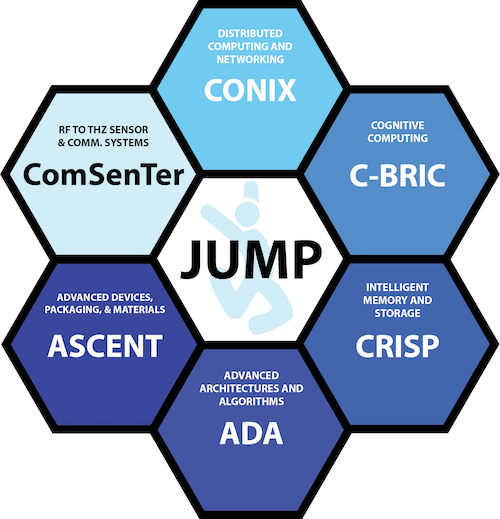The Partnership Seeking to Jumpstart Microelectronics Innovation

DARPA’s $200 million JUMP program aims to create a leap forward in U.S. electronics innovation. Image Courtesy of DARPA
Latest News
January 22, 2018
For decades, Moore’s Law has been synonymous with scaling compute productivity. But given the rise of data-driven applications and the new era of machine learning and artificial intelligence, the long-standing principle rooted in cheaper-to-manufacture chips that become more powerful each year appears to be running out of steam. To circumvent that roadblock is a new collaborative effort aimed at developing advanced microelectronics technologies that will jumpstart semiconductor innovation.
As part of DARPA’s Joint University Microelectronics Program (JUMP), a five-year, $200 million cost-share initiative, industry partners and university research centers are coming together to drive a new wave of research aimed at unleashing disruptive microelectronics-based technologies. The goal of the effort is to innovate solutions that will address the performance and scalability limitations of today’s electronics systems with new technologies that will serve the needs of DARPA and industry players well into the 2025 to 2030 time frame.
 DARPA’s $200 million JUMP program aims to create a leap forward in U.S. electronics innovation. Image Courtesy of DARPA.
DARPA’s $200 million JUMP program aims to create a leap forward in U.S. electronics innovation. Image Courtesy of DARPA.“Through these university teams, we’re seeking innovative solutions to tough technical challenges so we can overcome today’s limitations in the performance and scalability of electronic systems,” said Linton Salmon, DARPA’s program manager for JUMP, in a press release.
Six JUMP research centers have been established with support from from over 30 universities. In addition, DARPA, in concert with the non-profit Semiconductor Research Corp., has recruited an array of cost-sharing partners, including Analog Devices, ARM, IBM, Intel, Lockheed Martin Corp. Northrop Grumman Corp., Raytheon, TSMC, Samsung, and others. DARPA is providing close to 40% of the funding for the research efforts with industry consortium partners covering the remainder.
As part of the JUMP initiative, four research centers will be focused on “vertical” efforts covering areas like cognitive computing, intelligent memory and storage, distributed computing and networking, and sensor and communications systems. For example, the Center for Brain-Inspired Computing Enabling Autonomous Intelligence (C-BRIC), led by Purdue University, will channel their efforts toward delivering major advances in cognitive computing to support a new generation of autonomous intelligent systems like self-flying drones and personal robotic assistants. The Center for Research on Intelligent Storage and Processing-in-memory (CRISP), led by a University of Virginia academic, will seek to topple the “memory wall,” which is a decades-old bottleneck in computer systems hampering how big data can be leveraged.
Along with the vertically focused research centers, there are two horizontal centers as part of the JUMP plan. Here, the players are charged with developing disruptive breakthroughs in areas important for the JUMP sponsors, including architectures and algorithms, and advanced packaging and materials. The University of Michigan’s new Applications Driving Architecture (ADA) Center, for example, is pursuing technology to democratize the design and manufacturing process of advanced computing platforms. As part of the ADA’s efforts, nine universities will work together to come up with a modular approach or “plug and play” ecosystem to rethink design and reduce the skills barrier required to develop advanced microelectronics systems.
ADA’s work, led by University of Michigan and including researchers from Harvard, MIT, Stanford, Princeton, University of Illinois, and University of Washington, will encompass agile system development, algorithms-driven architecture, and an open-source chip scaffold, which would include all necessary support systems.
Below is a video on Notre Dame University’s center, which is exploring low-energy systems as part of the DARPA and Semiconductor Research Corp. JUMP efforts to advance microelectronics innovation.
Subscribe to our FREE magazine, FREE email newsletters or both!
Latest News
About the Author
Beth Stackpole is a contributing editor to Digital Engineering. Send e-mail about this article to [email protected].
Follow DE





